
Imperforate hymen
The infant may have a bulging, yellow-gray mass at or beyond the introitus. Several case reports describe the presence of an abdominal mass in association with urinary obstruction.
Ultrasonography is an essential first step in diagnosis, precluding unwise and unplanned surgical intervention with resultant injury to the urethra or other pelvic structures, and excluding other more complicated anomalies
Diagnosis depends on an awareness of the condition as a possible anomaly, and surveillance with well-child care. When the condition presents as abdominal pain or an abdominal mass (see image below), diagnostic testing is often extensive because the condition is not considered.[1]
An abdominal mass may prompt the consideration of an ovarian tumor and tumor markers may be obtained. While a false-positive elevation of CA-125 in premenopausal women has numerous causes, and testing has thus been discouraged, elevated CA-125 and 19.9 have been described with imperforate hymen, and may delay the diagnosis.[12, 13]
After initial presentation and suspected diagnosis of an obstructive anomaly in an adolescent, the use of continually-administered oral contraceptive pills to suppress menses allows symptomatic relief and essential time needed to obtain further diagnostic studies. In addition, the use of nonsteroidal anti-inflammatory drugs can provide pain relief; narcotic analgesics may be required.
Surgical intervention for imperforate hymen should require only one definitive procedure to evacuate the retained secretions and to ensure the maintenance of patency. Simple drainage of the material confined beyond the hymen is contraindicated because it does not allow for adequate drainage of the thick fluid, is not definitive, and increases the risk of infection (pyometras).
Two techniques are most commonly advocated: simple incision and small excision of the membrane. Simple incision of the hymen may be associated with postoperative stenosis with strictures, and it is not the method generally preferred at many centers. Use of an X -shaped incision ought to be the method of choice.
An elliptical excision of the membrane is performed close to the hymenal ring, using needle-tip cautery, followed by evacuation of the obstructed material. This technique is considered to be most effective in definitive treatment. Avoid compressing the uterus and fallopian tubes to speed evacuation of the trapped contents after the hymen is incised.
No comments:
Post a Comment